-
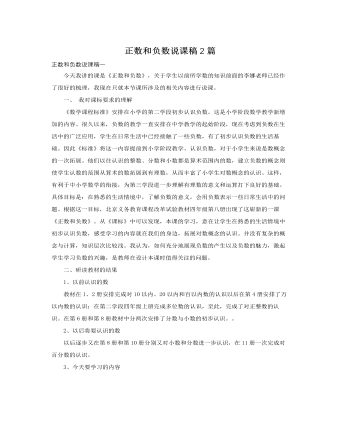
人教版新课标小学数学六年级下册正数和负数说课稿2篇
师:非常正确。现在我们知道了表示方法,但是我们该怎么读呢?也就是说我们现在知道了怎么用数学符号去表示,或者说是会书写了。但是我们要说给别人听该怎么说呢?也就是该怎么读它呢?(正号!)正确。这两个符号在我们数学的术语里面又有了另外一个称呼,就是“+”在这里读着“正号”,“-”在这里读着“负号”。这个读法是数学里面规定的,是我们日常用语中的习惯读法。这里的+5,+6而不是我们所说的加上5,加上6,加是一个运算过程,而正号只是一个符号,它可以和数字组合在一起作为是整体的,是一个整体的数字,是不含运算的。同理,这里的-5,-6它也不是减去5,、减去6,而是一个-5、-6的数字。为了和我们的加号和减号相区分,所以我们就给了它另外一种读法。
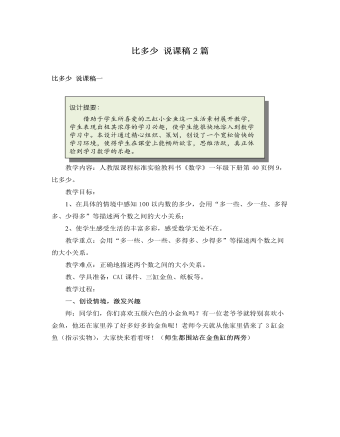
人教版新课标小学数学一年级下册比多少 说课稿2篇
五、总结与谈感受师:今天,我们学习了“比多少”(出示课题),同学们学会了用“多一些、少一些、多得多、少得多”来说明两个数之间的大小关系,还玩了猜数游戏,你们觉得这样的学习有趣吗?有什么感受呢?[总评]本课教学设计体现如下几个特点:1、 注重创设生活情境。从学生熟知的生活事例,感兴趣的事物(三缸小金鱼)引入,为学生提供了富有生活气息的具体情境。学生在具体情境中学习兴趣浓厚,积极性高涨,课堂气氛活跃,使学生以最佳的思维状态投入到学习中。2、注重体现学习方式。这节课学习过程,既注重培养学生独立思考的学习习惯,也注重培养学生合作交流的能力,不但学生个性思维方法得到了充分的展现,而且学生在合作交流中获取自己需要的信息,利于学生全面的发展。3、注重创设轻松课堂。猜数游戏的设计,创设了轻松愉快的课堂氛围,学生这样氛围中增长了知识,提高了能力,达到了寓教于乐的教学课堂境界,对学生学习数学兴趣产生不可量化的效果。
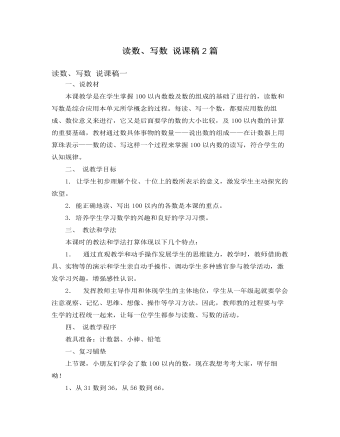
人教版新课标小学数学一年级下册读数、写数 说课稿2篇
读数时,先读十位上的数,再读个位上的数,十位上是几就读几十,个位是几就写读几,这个数读作“二十四”。设计意图:(由用小棒表示数过渡到用计数器上的珠子来表示,使学生初步理解数位的意义,会利用计数器正确读数、写数。)(4)教师出示4捆和2根小棒(即42根小棒),用同样的方法完成以上过程。当学生写出并读出42以后,让学生对比24与42中的“4”、“2”的意义,加深对不同数位上的数所表示的意义的理解。(设计意图:通过42与24的对比,加深对不同数位上的数所表示的意义的理解。)2.教学例5(1)第一行3题让学生独立完成,读给同桌的同学听,最后集体订正。(2)第二行第1题教师引导学生观察,十位上有4颗珠子,个位上一个也没有,试问:这个数该怎么写呢?学生回答后,教师板书“40”,并强调“当个位上一个也没有时,要用0占位”。
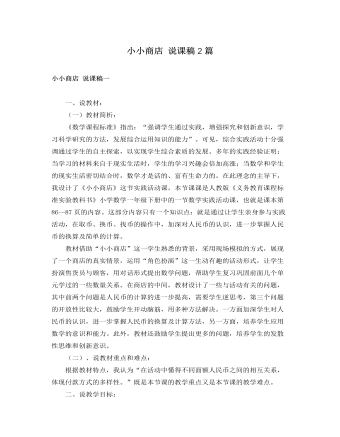
人教版新课标小学数学一年级下册小小商店 说课稿2篇
一、注意联系生活实际创设数学活动。教学要成功就必须要激发学生的兴趣和求知欲,让学生积极主动地参与到学习过程之中,使学习成为他们迫切的需要。“玩”是儿童的天性,在设计这节课时,我注重让学生在活动中体验数学知识,做到“在玩中学,在学中练”,完成了由知识到能力的升华。这节课一共设计了三个紧密联系的活动。1.活动一,到小精灵购物广场去买东西。这个活动由小淘气带领大家到小精灵购物广场去买东西,通过购物这个具体情境,让学生学会简单计算,学会计算的思考过程和如何付钱的方法,并体会到付钱的方法有多种形式。2.活动二,到游乐场去。恰逢六一儿童节即将来临,根据学生的喜好,创设了到游乐场去玩的情景,用20元钱去游乐场活动,你想做那些游戏呢?这个题目是在20元这个范围内,让学生进行有关元、角、分的计算。通过这个情境使学生进一步学习有关元、角、分的知识。3.活动三,合伙开百货店。
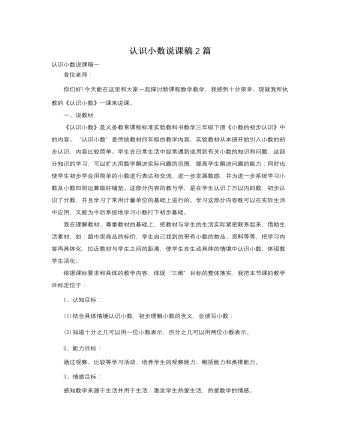
人教版新课标小学数学三年级下册认识小数说课稿2篇
(一)创设情境,引入新知1、引出小数新课程标准强调数学与现实生活的联系,要求数学教学必须从学生熟悉的生活情景和感兴趣的事物出发,使他们体会到数学就在身边,也感受到数学的趣味和作用,增强学生的数学应用意识。一开始我便与学生谈话:汤老师周末带孩子去超市买东西,可是他看不懂商品的价格,你们愿意帮他吗,(愿意)。大家一起帮他读出这些文具的价格是多少钱。激发了学生的兴趣,让学生充满爱心和自信心走进课堂。然后请学生仔细观察这些价格,有什么不同,从而引出小数的概念。2、教学读法我充分相信学生的能力和知识广度。聪明的学生可能一下子就能读出小数,有的学生家长教过或听到过小数怎样读,所以我让学生大胆试一试,然后经过学生小组讨论总结出小数的读法。
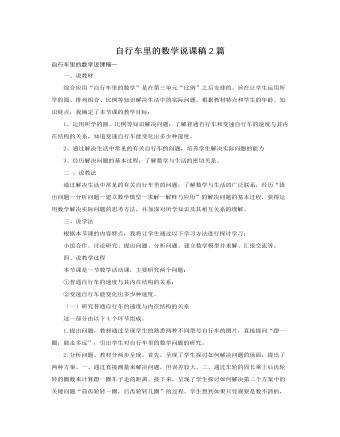
人教版新课标小学数学六年级下册自行车里的数学说课稿2篇
(三)实践活动(运用)接着,我设计了实践活动,让学生走出教室,在校园找到不同型号的自行车有四辆我把学生分成四组,并且分工合作,每组5个人,有3 个人负责采集数据,有两个人负责计算出结果。教师还要在旁边指导测量的方法,让学生学会收集数据。培养学生学会用数学的眼光观察现实生活,从中发现问题,提出问题,解决问题,体会数学的广泛应用与实际价值,获得良好的情感体验。数学模型方法的教学,还要培养学生运用模型解决现实问题的能力。因此,在学生理解模型之后,老师提供各种各样的现实问题,引导学生运用所得的数学模型去解决。在这个过程中,教师的指导非常重要,教师要指导学生把现实问题的元素与数学模型中的元素建立丐联系,还要指导学生如何运用已经建构的数学模型来分析和处理问题。学生经历了这样的学习过程,他们才会感受到数学模型的力量,才会感受到数学学习的乐趣。
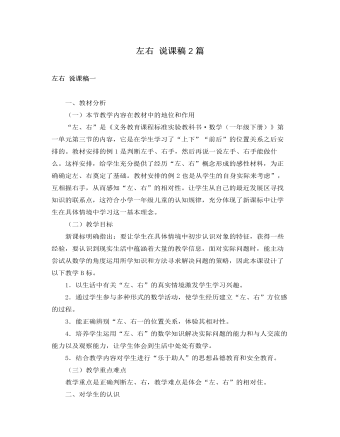
人教版新课标小学数学一年级下册左右 说课稿2篇
低年级儿童好奇、好动,知识的学习和巩固应考虑儿童的年龄特征,因此,学生的学习应以活动为主,从学生的兴趣入手。基于学生在生活中已经对“左右”积累了一定的感性经验,但不一定准确判断的情况下,我给学生充分的时间和空间,让学生通过说、找、做、摆、看、练的活动,逐渐加深对“左右”的位置关系的认识。1、说。是从生活经验入手,说左右手分别能做哪些事,这是对左右的初步认识。2、找。是找像左右手这样的好朋友,这是对左右的进一步了解。3、做。这是听口令做动手的小游戏。除了能调动学生的学习积极性,还能加深学生区别左与右。4、摆。通过摆学具,使学生把对左右的认识变成得心应手的知识。5、看。这是让学生观察由于他们的转动,右边事物的不同,初步体验左右的相对性。6、练。达到巩固认识“左右”的位置关系,培养学生会运用所学知识解决生活中的实际问题的能力,体验数学与生活的密切联系。
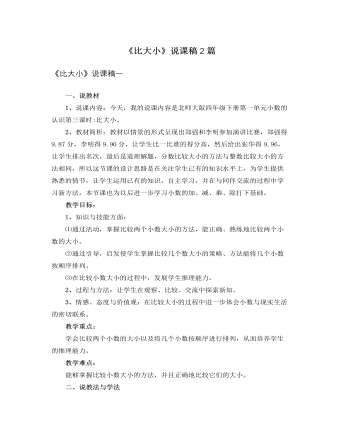
北师大版小学数学四年级下册《比大小》说课稿2篇
一、教材分析《歌手大赛》是北师大版材四年级下册第一单元《小数的意义和加减法》的最后一课,实质教学内容是小数的加减混合运算。它是在学生已经熟练掌握了整数的混合运算,认识了小数的意义和性质,掌握了用竖式计算小数加减法的基础上安排的教学内容,是数的运算中不可缺少的内容。教学目标:知识目标:结合具体情境,能正确进行小数加减混合运算,并能选择简单的方法进行计算。能解决简单的小数加减法的混合运算的实际问题,增强数学应用意识。能力目标:能熟练运用小数加减法,通过对“谁的总分高”的探究,让学生自己先估算,再组织学生独立探究,并在全班进行交流,增强学生的计算能力及解决实际问题的能力。情感目标:使学生在参与、思考、交流的过程中,体验获取知识的快乐。
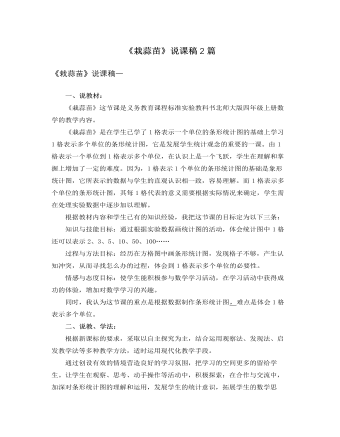
北师大版小学数学四年级下册《栽蒜苗》说课稿2篇
2、试一试。给学生每人一张6×6的方格图,让学生在方格图中根据黑板的统计表画出条形统计图。学生会兴趣盎然地拿起笔画起来。画着画着,就会有学生发现格子不够。此时,我会抓住这一有意的预设,佯装问学生:什么格子不够啊?学生会争着举手说出自己的发现。接着,我会问,那怎么办啊?你们有什么好主意吗?学生思考之后,小主意会一个接一个出现。有人会说:在上面加格子啊。还有人会说:画到顶之后,再接着从下面画。根据学生的主意,我会一一故意设障,比如说:格子上面已经有标题了,无法加格子了。又比如说:建一栋10层的楼房,能不能建到8层以后,再双从地面上建2层,这还算是10层楼吗?经过这一激烈的对话,自然就会有人说:能不能一格表示2?这正是教者我想要的答案。于是接着让学生试着画条形统计图。画着画着,也会有学生提出:一格表示2,那么3怎么表示啊?这个问题我可以不直接回答,而是集思广义,让学生说出怎么办。
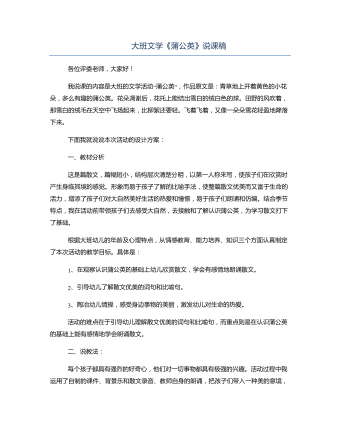
大班文学《蒲公英》说课稿
一、教材分析这是篇散文,篇幅短小,结构层次清楚分明,以第一人称来写,使孩子们在欣赏时产生身临其境的感觉。形象而易于孩子了解的比喻手法,使整篇散文优美而又富于生命的活力,增添了孩子们对大自然美好生活的热爱和憧憬,易于孩子们朗诵和仿编。结合季节特点,我在活动前带领孩子们去感受大自然,去接触和了解认识蒲公英,为学习散文打下了基础。根据大班幼儿的年龄及心理特点,从情感教育、能力培养、知识三个方面认真制定了本次活动的教学目标。具体是:1、在观察认识蒲公英的基础上幼儿欣赏散文,学会有感情地朗诵散文。2、引导幼儿了解散文优美的词句和比喻句。3、陶冶幼儿情操,感受身边事物的美丽,激发幼儿对生命的热爱。活动的难点在于引导幼儿理解散文优美的词句和比喻句,而重点则是在认识蒲公英的基础上能有感情地学会朗诵散文。二、说教法:每个孩子都具有强烈的好奇心,他们对一切事物都具有极强的兴趣。活动过程中我运用了自制的课件、背景乐和散文录音、教师自身的朗诵,把孩子们带入一种美的意境,使孩子们在优美的意境中感受了散文的语言美,体验学习散文的快乐。活动的开展由易到难,层层深入,使孩子们能主动积极、自愿地参与和学习,获得经验,体验了孩子的主体地位,也正好契合了《纲要》中关于“教师应成为幼儿学习活动的支持者、合作者、引导者”的理念。此外我还采用了欣赏倾听法、谈话交流法、游戏表演法引导孩子在活动中敢说、想说、愿意说,树立了孩子的自信心,从而使本次活动达到美的享受,快乐学习的和谐统一。
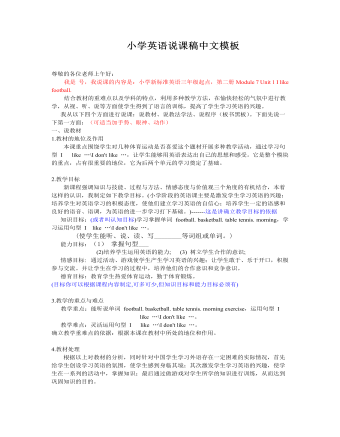
小学英语说课稿中文模板
一、说教材1.教材的地位及作用 本课重点围绕学生对几种体育运动是否喜爱这个题材开展多种教学活动,通过学习句型 I like …\I don't like …,让学生能够用英语表达出自己的思想和感受。它是整个模块的重点,占有很重要的地位,它为后两个单元的学习奠定了基础。 2.教学目标 新课程强调知识与技能、过程与方法、情感态度与价值观三个角度的有机结合,本着这样的认识,我制定如下教学目标。(小学阶段的英语课主要是激发学生学习英语的兴趣;培养学生对英语学习的积极态度,使他们建立学习英语的自信心;培养学生一定的语感和良好的语音、语调,为英语的进一步学习打下基础。)-------这是讲确立教学目标的依据 知识目标:(或者叫认知目标)学习掌握单词 football. basketball. tabletennis. morning,学 习运用句型 I like …\I don't like …。
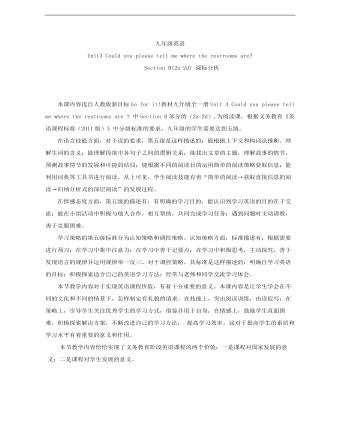
初中英语人教版九年级全册《Unit 3 Could you please tell me where the restrooms are》课标分析说课稿
学习策略的第五级标准分为认知策略和调控策略。认知策略方面,标准描述有:根据需要进行预习;在学习中集中注意力;在学习中善于记要点;在学习中积极思考,主动探究,善于发现语言的规律并运用规律举一反三。对于调控策略,其标准是这样描述的:明确自学习英语的目标;积极探索适合自己的英语学习方法;经常与老师和同学交流学习体会。
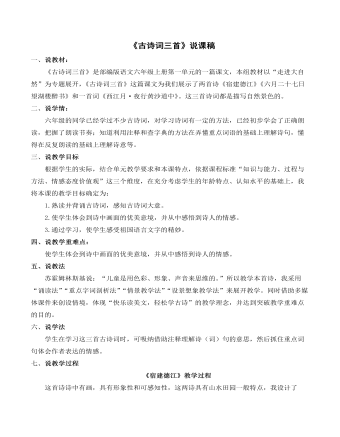
《古诗词三首》说课稿 (2)
1.熟读并背诵古诗词,感知古诗词大意。? 2.使学生体会到诗中画面的优美意境,并从中感悟到诗人的情感。?3.通过学习,使学生感受祖国语言文字的精妙。? 四、说教学重难点:使学生体会到诗中画面的优美意境,并从中感悟到诗人的情感。? 五、说教法? 苏霍姆林斯基说:“儿童是用色彩、形象、声音来思维的。”所以教学本首诗,我采用“诵读法”“重点字词剖析法”“情景教学法”“设景想象教学法”来展开教学。同时借助多媒体课件来创设情境,体现“快乐读美文,轻松学古诗”的教学理念,并达到突破教学重难点的目的。六、说学法 学生在学习这三首古诗词时,可吸纳借助注释理解诗(词)句的意思,然后抓住重点词句体会作者表达的情感。
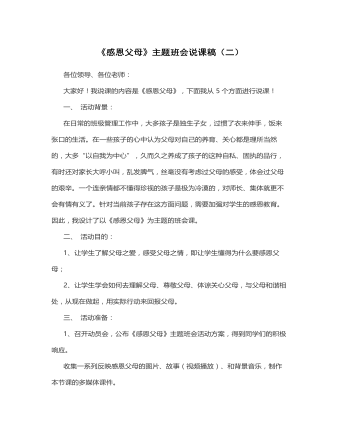
《感恩父母》说课稿 (2)
(你有邹越老师讲到的类似经历吗?请你结合自己的经历谈谈观看感受?)(展示视频重点,引发学生思考)78可怜天下父母心/儿行千里母担忧 /母行万里儿不愁这句话的含义教师启发引导(发动同学们讲自己的亲身故事,谈论观点,从他人的故事散发到自身,从而审视自我问题):讲完了这些故事,我的眼睛湿润了,此时此刻相信每一位同学的心情都无比的沉重,父母亲的爱在儿女面前是那么的无私而博大。设问你是不是一个有故事的人?请大家回想现实生活中父母为我们做过的,你为之动情的一两件事。(教师总结)如果说母爱是水,温柔而恬静,那父爱就是海洋,博大而深沉;现在,就让我们全体起立,用心去写孝道,我们宣誓,把心中对父母深深的感恩告诉他们,然后给我们的爸爸、妈妈一个深深的一鞠躬和最真诚的拥抱(配以音乐)

人教版高中英语必修1Journey Down the Mekong说课稿
2. let the Ss complete the forms paragraph by paragraph. Purpose here is to help Ss to get the habit of reading a passage as a whole, and pay attention to the organization of the text, as a result the Ss will fully understand the whole passage.3. ask Ss to retell the passage with the help of the key words in the form.Since the Ss in the class are in different levels, so I let them to fill in the blank to understand the meaning of the words and phrases better. ( That’s all for the while-reading. Now let’s move to the fifth step.)Step V: Post-reading (10mins) ---DiscussionIn this part students are asked to discuss in groups and list Wang Kun’s and Wang Wei’s attitudes about the trip. After that, Ss are encouraged to express their attitudes with the whole class. Collect their answers and don’t forget to praise them even if their answers may not be perfect.In this activity, discussion provides a vivid and active learning environment for Ss to communicate in English with newly learned language items. (Finally it comes to the homework.)StepⅥ: Homework (1min)1. Ss are required to read the text again after class and figure out the meaning of some complex sentences.2. Do the exercises on P19; This can help Ss to consolidate what they’ve learnt and make preparation for the next lessonPart4. Blackboard design.(说板书设计)On the top, there is the title of this lesson. On the left, there are main ideas for each paragraph. On the right, there are some new words and expressions.Unit 3 Travel journalJourney down the MekongMain idea of each para.:Para1: deciding to take a great bike trip along the Mekong river.Para2: Different attitudes between Wang kun and Wang wei.

人教版高中英语必修1English around the world说课稿
(3)v. 给:提出;展现,显现present sb. with sth. ; present sth. to sb. 把. . 交给;颁发;授予present sth. (for sth. )/present sth. to sb. e. g. Om his birthday, his friends presented him a collection of stamps. 在他生日时,他的朋友们送给他一套邮票作为礼物。The sword was presented by the family to the museum. 这家人把宝剑捐赠给了博物馆。The committee will present the final report to Parliament in June. 委员会将在六月向议会提交最后的报告。You need to present yourself better. 你需要更善于展现自己。It is essential that we present a united front. 至关重要的是我们要表现得更加团结。Step 4 ConsolidationT:Now that we have got a general idea of these words and phrases. Lets make up some sentences using them to master them. Suggested sentences:1. Your duties include typing letters and answering the telephone. 2. It is one of the greatest roles that she has played. 3. A large number of people have applied for the job. 4. The number of the panda is declining. 5. I'11 go there, even if I have to walk. 6. He came up to me to ask for a light. 7. The novel is about a family who can't communicate with each other. 8. He based his plan on interests of most people. 9. Why doesn't he make use of his singing talent?Step 5 Summary and homeworkT:Today we dealt with several new words and phrases. After class I hope that youcan read them again and again to keep them in mind. That's all for today. You aredismissed.

人教版高中英语必修3Astronomy the science of the stars说课稿3篇
Step 2 Pre-listeningAfter students finish their discussion, I will show a picture of Newton and ask them: Who is him? What is he famous for? Could you find out some words to describe him? Maybe students will answer that he is genius for his finding of theGravitation, making a great contribution to the progress of human being. At that time I will show another two pictures of Einstein and Hawking, letting students guess who they are and write down their idea about the Gravitation. For I have arranged them to search more information about the gravity before this class, Students have beenfamiliar with the topic and will not be afraid about this abstract conception, which is helpful for their listening.Step 3 While-listeningIn this step, students will be required to listen the material for three times. The first and listening is extensive listening and the second and third listening is intensive listening. In the first time, They are required to listen a material including Part 1 and Part 2 and choose the best summary of the listening text. After they choose the right answer, They also need work in group to explain what is wrong with the others. Then I will make a conclusion that we should pay attention to the first paragraph and last paragraph and some keys to get the main idea. By doing this, their capacity of generalization will have a great improvement.Before the second listening, I will ask students to scan the blank on the power point quickly and ask them to note down some key words .Then ask them to listen to the Part 1again and fill the first column of the chart. Maybe some students just show the ideas of these three scientists an still can’t catch their development of gravity. Therefore, I will ask them to listen to Part 2 again and fill in the rest. After finish the listening, I will give them ten minutes to discuss with their partner. I will also guidethem to improve their answers when they discuss with others.

人教版高中英语必修4A taste of English Humor说课稿3篇
Then I would ask them to think of a funny English or Chinese and tell it to partners. While telling stories, they can use expressions and some acting to help make the story funny. 5 minutes would be given to do this.Those stories they told there will be the material for their writing. Soletting them tell it at first is helpful. And they can make a difference between telling a funny story and writing it down. Generally speaking, it is difficult forstudents to write well because they don’t know what to write and how to write. Asking them to tell their own stories at first can help them come up with what to write.After their telling, I would invite someone to share his/her story with all of us and I would write it down on the blackboard.This example story would be used as a sample to illustrate the format of funny story. Different from a story from teacher or textbook, a story from students can obviously become a interesting material to draw students’ attention.Then I would ask the whole class to put this story into several parts. It might be a little bit difficult for them. So I would ask them to find out whether all the sentences are necessary. After delete some sentences, there are 6 sentences left behind. Then they can easily put them into three parts. After interaction with students, I would teach them the right terms for each part and conclude the format of funny story.This step is the key and difficult point in my lesson. So I mainly usetask-based teaching method in this part and the task for students was divided into several stages. With the separated difficult level, students can find there are usually three parts in writing. They can also learn to write without the unnecessary parts in the process of analyzing. And then I wouldn’t rush to tell them the right terms to them directly. Instead, I would ask them to name them by their own. A confused mind is better for acquiring knowledge.While-writing:Then I would give students 7 minutes to write down this story, without other requirements.With all the preparations in pre-writing, students’ difficulties were cleared. So it would be much easier for them to write down the story within 7 minutes. There are no other requirements because students’ first writing is actually a drafting. It would be revise and edit several times later. Writing, as a skill

人教版高中英语必修3Canada-the true north说课稿4篇
Good afternoon, teachers, It’s my great pleasure to be here sharing my lesson with you.The content of my lesson is Senior English Book 3 Unit 5 Canada —— “The true North”.I’ll be ready to begin this lesson from five parts. Analysis of the teaching material,the teaching methods,the studying methods, the teaching procedure,and Blackboard design.First, let me talk about the teaching material.Part 1 Teaching Material:This unit is about the introduction of Canada. By studying of this unit,we’ll enable the students to learn the geography, population, main cities, and natural beauty, natural resources of Canada. Through the training of the unit, it also requires students to learn some Language skills such as the expressions of position and emotions.So it plays an important part in the English teaching in this book.After studying the teaching material and analyzing the rule of children’s growing of mind,I think the teaching aims are the followings:1.Knowledge objects:(1) make the students learn some new words and phrases(2) make the students understand the content of the lesson.2.Ability objects:(1)To develop the Ss’ abilities of listening, speaking, reading and writing. Especially reading and speaking ability.(2) learn to talk about the characters of Canada in English(3)To train the Ss’ ability of working in pairs.3.Emotion objects:(1)Enable students to understand the characters of Canada..(2)Stimulate Ss to work hard to make China stronger.Part 2 Teaching Methods:I think helping students learn to master new words and phrases and improve the students’ reading and speaking ability is import and the difficult.According to the analysis of the teaching material and the import points and the difficult points,I will use the following teaching methods : question-guiding approach; fast-reading and careful reading; multi-media teaching methods; discussion

人教版高中英语必修4Working The Land说课稿3篇
Knowledge objectives:(1) to make Ss grasp the usage of words, expressions and sentence structures: statistics, struggle, thanks to, rid of, some patterns for persuasion, the “ing” form as subject and object;(2)to use learnt knowledge to persuade sb.Ability objectives:(1) to develop Ss’ reading skills(skimming, scanning, word guessing);(2) to improve Ss’ speaking, communicating and cooperating skills.Emotional objectives:to make Ss know the contribution of Yuan,and learn his spirit and his simple life time.Teaching important and difficult points:(1) some words, expressions and sentence structures mentioned above;(2)the content of the text;(3)training their reading and speaking skills.Teaching methods: CLT, TBLT,QT.Learning strategies: CLS, QLS, TBLS.Teaching procedures:Step 1 lead-in: (1) teacher plays a piece of recent news from CCTV about the harvest of the super hybrid rice, and ask students whether they know Yuan or not, and talk about him and his contribution.(2)Brain storm: let Ss describe Yuan in their minds including his appearance, his living condition and so on.Step 2 fast reading tasks:(1)teacher introduces Yuan and super hybrid rice(2)make Ss read the text as fast as possible with questions. Such as: what’s the general ideaof this passage? What’s Yuan’ dream? (skimming and scanning skill)Step 3 intensive reading tasks(1)let Ss read the text silently, find topic sentence of each paragraph and draw the difficult sentences and the knowledge what they don’t understand.(words guessing)(2)teacher and Ss talk about the important words, expressions and sentences together, and ask Ss to retell the content of the text.(summarizing and paraphrasing)(3)teacher summarize this part.(4) read again following the courseware.